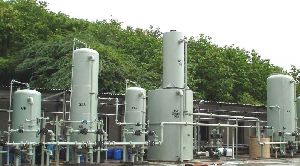
DM Plant
Get Price Quote
WHAT IS A DM PLANT? Demineralization plant produces clear water which is free from salts by ion exchange process. Raw water is passed through two ion exchange chambers, which are connected in series. In the first chamber cations get exchanged hydrogen ions and in the second chamber anions gets exchanged with hydroxyl ions. HOW IT WORKS DM plant consists of two pressured vessels connected in series. The first unit consists of acidic cations, which converts positive ions of salts and replaces them with hydrogen ions, to form respective acids. Second unit consists of basic anion exchange resign, which observes the salts from first chamber. Further purity in water can be achieved by Mixed bed Deionizer, which is a single column unit which is filled with acidic cation and basic anion. There are four stages in deionizer: Service: In the Service cycle the water enters the vessel and passes through the Resin bed of the respective exchanger Backwashing: Backwashing is done, once the resins are exhausted. Backwashing is done by uniform flow of water. The backwash is done to expand the resign bed and removes foreign bodies in resin bed. Regeneration: When the ion exchange resins lose its nature of exchanging ions, they have to be regenerated. This can be done by mixing 4 – 5% concentrated solution of Hydrochloric acid is used for cation resin and a 4% – 5% concentrated solution of caustic soda for anion resin. Rinse: The final stage of regeneration is to rinse the resins of excess regenerate

Ultra Filtration Plant
Get Price Quote
Ultra filtration is a method of removing very small particles from liquid. A membrane used with this method usually has pores that are 0.01 to 0.001 microns in size. This is small enough to remove most bacteria, viruses, high molecular weight substances, and polymer-type molecules. During ultra filtration the flow of liquid gets split into two streams, which is known as cross-flow separation. One stream goes through the porous membrane and is then called permeate, and the other is concentrated in the particles and other matter that have been unable to penetrate the membrane.The process is commonly used for treating drinking water in compliance with strict standards. Many organisms have become resistant to other methods of disinfecting water, but an ultra filtration system removes pathogens by moving water through a membrane, physically removing each organism. The membranes themselves are often formed into small, hollow fibers that are less than a millimeter (about 0.04 inches) in diameter, which are bundled by the thousands in a filter housing. Modules that contain the membranes come in a variety of configurations, including spiral-wound, plate-and-frame, and tubular. The type and concentration of material that needs to be removed helps determine what kind of configuration is used. Ultra filteration is low pressure crossflow membrane process for separating selective molecular weight species from a feed system. The separation is based on selective MWCO (Molecular weight cut-off) Water, Salts and Low molecular weight species selectively pass through the membrane for discharge, reuse or further treatment. Ultrafilteration selectively removes Macromolecules Suspended Solids Turbidity Organics Bacteria Oil and Grease Surfactants Pigments Metal Hydroxides
Best Deals from Demineralisation Plants